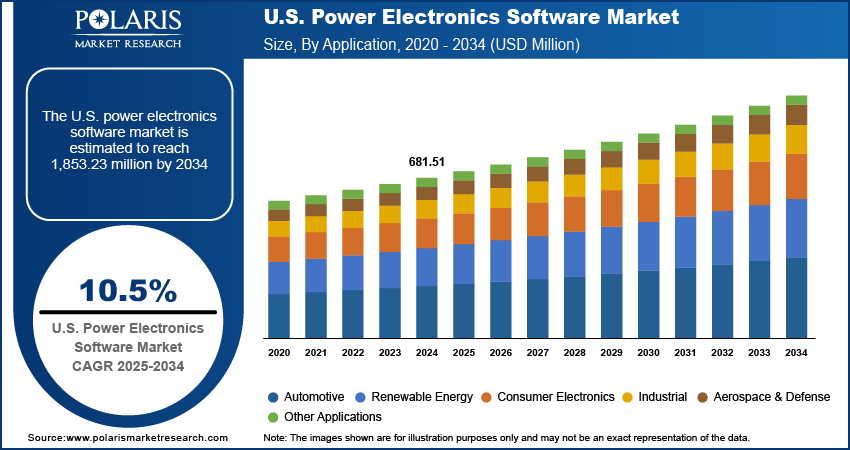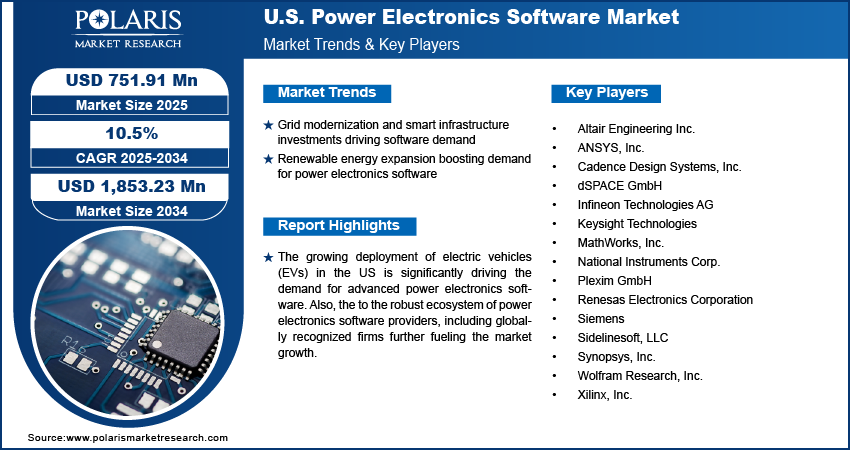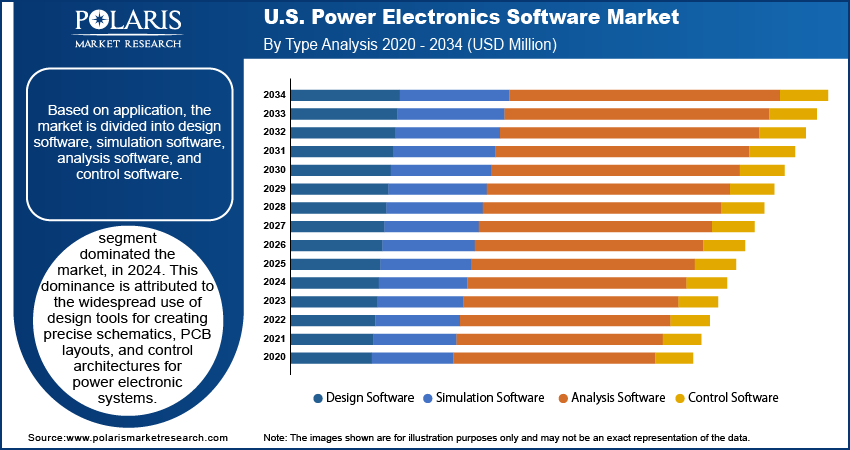
U.S. Power Electronics Software Market Size, Share, Trends, & Industry Analysis By Technology (RCP, Embedded System Prototyping, MBD, HIL Simulation, and Other Technologies), By Type, By Application, and By Country – Market Forecast, 2025–2034
- Published Date:Jul-2025
- Pages: 120
- Format: PDF
- Report ID: PM5907
- Base Year: 2024
- Historical Data: 2020-2023
Market Overview
The U.S. power electronics software market size was valued at USD 681.51 million in 2024, growing at a CAGR of 10.5% from 2025–2034. Grid modernization and smart infrastructure investments coupled with renewable energy expansion is boosting the demand for power electronics software.
The US power electronics software market is witnessing robust growth, driven by rising demand for digital design, simulation, and control tools across energy, transportation, and industrial sectors. The increasing emphasis on electrification, renewable energy deployment, and modernization of the national grid is propelling favorable conditions for software platforms that support the development and optimization of power electronic systems. These systems include inverters, converters, power controllers, and battery management solutions that form the backbone of emerging clean technologies. Power electronics software enables engineers and designers to simulate system behavior, perform rapid prototyping, and conduct real-time hardware-in-the-loop (HIL) testing, which are crucial in ensuring energy efficiency, safety, and regulatory compliance.

To Understand More About this Research: Request a Free Sample Report
Industrial automation and aerospace sectors are adopting advanced control software to optimize system-level performance, reduce losses, and improve fault diagnostics. The integration of AI, machine learning, and edge computing into power electronics design is accelerating the adoption of next-generation simulation and control platforms across the US.
The growing deployment of electric vehicles (EVs) in the US is significantly driving the demand for advanced power electronics software. A key contributor to this growth is the Inflation Reduction Act (IRA), which includes federal tax credits of up to USD 7,500 per qualifying EV, along with funding for domestic battery manufacturing and charging infrastructure. These federal measures are accelerating EV production and sales across the country, boosting the need for simulation and control tools for electric powertrain systems, battery management, and charging networks. As per the International Energy Agency report, electric vehicle sales in the U.S. rose from 0.8 million units in 2022 to 1.2 million units in 2024. The growing complexity of EV platforms is driving automakers and Tier 1 suppliers to depend more heavily on high-precision modeling and embedded control software to optimize system performance, enhance energy efficiency, and meet evolving regulatory standards. This positions power electronics software as a key factor of electric mobility across the U.S. automotive value chain.
In addition, the US market is growing due to the robust ecosystem of power electronics software providers, including globally recognized firms such as MathWorks, Keysight Technologies, and Cadence Design Systems. These companies maintain deep integration with domestic automotive, aerospace, industrial automation, and energy firms, enabling them to co-develop application-specific toolchains. Their local presence and established partnerships with OEMs, research institutions, and semiconductor manufacturers facilitate the rapid customization of simulation and design platforms for power converter topologies, motor drives, and digital control systems.
Industry Dynamics
Grid Modernization and Smart Infrastructure Investments Driving Software Demand
The growing US government investments in grid modernization is accelerating the growth of the power electronics software market in the country. In April 2023, the US Department of Energy (DOE) announced a funding initiative of USD 38 million to support National Laboratories in advancing critical R&D needed to develop a grid that is resilient, reliable, secure, and sustainable. This initiative highlights a strong national commitment to upgrading energy infrastructure through advanced power electronics systems such as converters, inverters, and control systems. These systems require highly accurate simulation and design software to manage power flow, ensure grid stability, and enhance fault tolerance under real-world operational conditions. The deployment of high-performance software tools in smart grid components is becoming essential for utilities and equipment manufacturers across the US.
The complexity of integrating distributed energy resources and electric mobility solutions into the national grid is further increasing the reliance on simulation-driven software platforms. Design engineers are leveraging rapid control prototyping and model-based development tools to validate inverter performance, predict thermal behavior, and optimize control logic. In smart infrastructure projects, real-time monitoring and embedded control software are enabling utilities to respond dynamically to fluctuating grid conditions. The rapid shift in the U.S. toward a more intelligent and adaptive energy infrastructure makes precision power electronics design software essential for safe and efficient grid operations.
Renewable Energy Expansion Boosting Demand for Power Electronics Software
The growing capacity of renewable energy in the US, particularly from solar and wind installations, is increasing the adoption of power electronics software. For instance, in August 2022, the federal government introduced the Inflation Reduction Act (IRA), a landmark policy that extended and enhanced tax incentives for clean energy technologies over the next decade. The IRA is propelling substantial growth in renewable energy generation, resulting in heightened demand for sophisticated software solutions used in designing and optimizing energy conversion systems. Managing energy storage, regulating solar power flows, and controlling wind turbine converters requires precise simulation and control to ensure optimal performance. Power electronics software enables developers and engineers to model dynamic energy behavior, evaluate switching strategies, and improve the overall efficiency and safety of renewable power systems.
The growing scale and complexity of renewable projects highlight the increasing importance of digital tools in project planning and performance optimization. Simulation platforms provide grid-tied inverter models, fault diagnostics, and power quality assessments that help utilities and project developers achieve greater system resilience and compliance with interconnection standards. The shift toward hybrid energy systems, incorporating both storage and distributed generation, demands highly integrated control strategies. These evolving dynamics are driving utilities, EPC firms, and system integrators in the US to invest in advanced power electronics software that supports real-time testing, scenario simulation, and lifecycle performance management.

Segmental Insights
Technology Analysis
The segmentation, based on technology includes, rapid control prototyping (RCP), embedded system prototyping, model-based design (MBD), hardware-in-the-loop (HIL) simulation, and other technologies. The model-based design (MBD) segment is projected to reach substantial share during the forecast period. This growth is attributed to the widespread adoption in the automotive, aerospace, and renewable energy industries. MBD empowers developers to virtually simulate, test, and validate power electronics systems before physical prototypes are created, significantly cutting both development time and associated costs. It supports early-stage design verification, reduces reliance on hardware prototypes, and enhances the development of advanced control systems. Leading automotive manufacturers and energy firms are increasingly adopting MBD tools due to robust multi-domain modeling capabilities and system-level simulation features. These functionalities are critical for engineering complex systems such as electric drivetrains and grid-connected inverters.
The hardware-in-the-loop (HIL) simulation segment is projected to register the fastest growth through 2034, spurred by the rising intricacy of electronic systems and the growing need for real-time testing. HIL platforms enable validation of control strategies and embedded software within a closed-loop environment without putting physical systems at risk. This makes them highly suitable for electric vehicle testing, motor control validation, and renewable energy applications. The growing emphasis on functional safety standards, such as ISO 26262 for automotive and IEC 61850 for power utilities, is further encouraging adoption of HIL systems for ensuring robust performance under variable operating conditions.
Type Analysis
The segmentation, based on type includes, design software, simulation software, analysis software, and control software. The design software segment dominated the market, in 2024. This dominance is attributed to the widespread use of design tools for creating precise schematics, PCB layouts, and control architectures for power electronic systems. These tools support the early-phase development of converters, inverters, and power modules across various end-use industries. The capability of design software to simulate component behavior under defined electrical and thermal parameters made them indispensable in product development workflows. Rising electrification in industrial and transport sectors is driving the need for advanced design software that supports innovation in energy-efficient solutions. These tools are becoming central to developing reliable and optimized power electronics systems.
The simulation software segment is anticipated to expand at the highest CAGR from 2025 to 2034 due to the increasing demand for dynamic modeling and predictive analysis in power system development. Simulation software enables engineers to analyze performance under different load conditions, conduct EMI/EMC studies, and validate thermal profiles with a high degree of accuracy. For instance, in June 2024, Siemens introduced the Solido Simulation Suite, delivering AI-accelerated SPICE, FastSPICE, and LibSPICE simulation engines for analog, mixed-signal, RF, and custom IC designs. The integration of AI and machine learning algorithms enhanced these platforms to deliver optimization suggestions, perform real-time scenario testing, and conduct rapid fault analysis. This evolution is transforming simulation software as an essential resource for R&D teams working in sectors such as electric vehicles, industrial automation, and aerospace power systems.
Application Analysis
The segmentation, based on application includes, automotive, consumer electronics, industrial, renewable energy, aerospace & defense, and other applications. The automotive segment growth is driven due to the rapid shift toward electric vehicles (EVs) and hybrid electric vehicles (HEVs). Manufacturers developing advanced traction inverters, onboard chargers, and power distribution units increasingly depend on power electronics software for component simulation, thermal analysis, and real-time control validation. For example, in January 2025, Infineon introduced the new EiceDRIVER isolated gate driver ICs designed specifically for traction inverters in electric vehicles. These drivers enable precise and reliable operation within inverter modules, allowing for enhanced switching performance and better electronic thermal management material critical aspects for traction applications. This reliance supports faster development cycles and improved system performance. Major OEMs and Tier 1 suppliers utilize software platforms to meet stringent efficiency standards, reduce switching losses, and optimize the layout of high-voltage powertrains. The increasing integration of silicon carbide (SiC) and gallium nitride (GaN) materials in EV systems further boosting the role of advanced simulation tools in automotive design.
The renewable energy segment is expected to be the fastest-growing during the forecast period. The expansion of solar PV and wind energy installations, along with global decarbonization initiatives, is accelerating the demand for power electronics software to optimize the performance of converters and grid-tied inverters. In this sector, simulation tools are used to manage fluctuating energy flows, improve power factor correction, and ensure compliance with grid codes. Government and utility investments in smart grid upgrades and hybrid energy storage are fueling demand for precise, software-driven control and monitoring systems. This trend is accelerating the demand for power electronics software across renewable energy applications.

Key Players & Competitive Analysis Report
The US power electronics software market is defined by the presence of multinational technology firms and domain-specific engineering software developers, competing through innovation, strategic alliances, and the continuous refinement of simulation capabilities. Companies operating in this space are expanding their offerings to include integrated design environments that facilitate seamless power electronics development from behavioral modeling and embedded control design to hardware-in-the-loop (HIL) testing and post-deployment diagnostics. Growing demand from electric vehicle infrastructure, smart grid modernization, aerospace electrification, and renewable energy integration is driving the adoption of software platforms that combine high simulation fidelity with real-time responsiveness.
Prominent players in the US Power Electronics Software Market include Altair Engineering Inc., ANSYS, Inc., Cadence Design Systems, Inc., dSPACE GmbH, Infineon Technologies AG, Keysight Technologies, MathWorks, Inc., National Instruments Corp., Plexim GmbH, Renesas Electronics Corporation, Siemens, Sidelinesoft, LLC, Synopsys, Inc., Wolfram Research, Inc., and Xilinx, Inc.
Key Players
- Altair Engineering Inc.
- ANSYS, Inc.
- Cadence Design Systems, Inc.
- dSPACE GmbH
- Infineon Technologies AG
- Keysight Technologies
- MathWorks, Inc.
- National Instruments Corp.
- Plexim GmbH
- Renesas Electronics Corporation
- Siemens
- Sidelinesoft, LLC
- Synopsys, Inc.
- Wolfram Research, Inc.
- Xilinx, Inc.
Industry Developments
February 2025: dSPACE introduced XSG Power Electronics Systems (XSG PES), a real-time simulation software designed to model highly dynamic power electronics circuits operating at switching frequencies of up to 500 kHz. The platform features a comprehensive library of pre-configured converter models based on wide-bandgap semiconductors such as silicon carbide (SiC) and gallium nitride (GaN).
November 2024: MathWorks, Inc. collaborated with NXP Semiconductors to roll out the Model-Based Design Toolbox (MBDT) specifically developed for Battery Management Systems (BMS). This toolbox aims to accelerate system development processes by enabling faster modeling, simulation, and code generation tailored to energy storage applications.
November 2024: Keysight Technologies launched a next-generation electronic design automation (EDA) software suite powered by artificial intelligence and machine learning. The new offering is engineered to simplify RF device modeling, improve simulation accuracy, and streamline the transition from design to verification, ultimately enhancing engineering productivity across multiple development platforms.
US Power Electronics Software Market Segmentation
By Technology Outlook (Revenue, USD Million, 2020–2034)
- Rapid Control Prototyping (RCP)
- Embedded System Prototyping
- Model-Based Design (MBD)
- Hardware-In-The-Loop (HIL) Simulation
- Other Technologies
By Type Outlook (Revenue, USD Million, 2020–2034)
- Design Software
- Simulation Software
- Analysis Software
- Control Software
By Application Outlook (Revenue, USD Million, 2020–2034)
- Automotive
- Consumer Electronics
- Industrial
- Renewable Energy
- Aerospace & Defense
- Other Applications
US Power Electronics Software Market Report Scope
|
Report Attributes |
Details |
|
Market Size in 2024 |
USD 681.51 Million |
|
Market Size in 2025 |
USD 751.91 Million |
|
Revenue Forecast by 2034 |
USD 1,853.23 Million |
|
CAGR |
10.5% from 2025 to 2034 |
|
Base Year |
2024 |
|
Historical Data |
2020–2023 |
|
Forecast Period |
2025–2034 |
|
Quantitative Units |
Revenue in USD Million and CAGR from 2025 to 2034 |
|
Report Coverage |
Revenue Forecast, Competitive Landscape, Growth Factors, and Industry Trends |
|
Segments Covered |
|
|
Competitive Landscape |
|
|
Report Format |
|
|
Customization |
Report customization as per your requirements with respect to countries, regions, and segmentation. |
FAQ's
The global market size was valued at USD 681.51 million in 2024 and is projected to grow to USD 1,853.23 million by 2034.
The US market is projected to register a CAGR of 10.5% during the forecast period.
A few of the key players in the market are Altair Engineering Inc., ANSYS, Inc., Cadence Design Systems, Inc., dSPACE GmbH, Infineon Technologies AG, Keysight Technologies, MathWorks, Inc., National Instruments Corp., Plexim GmbH, Renesas Electronics Corporation, Siemens, Sidelinesoft, LLC.
The design software segment dominated the market, in 2024.
The renewable energy segment is expected to be the fastest-growing during the forecast period.
